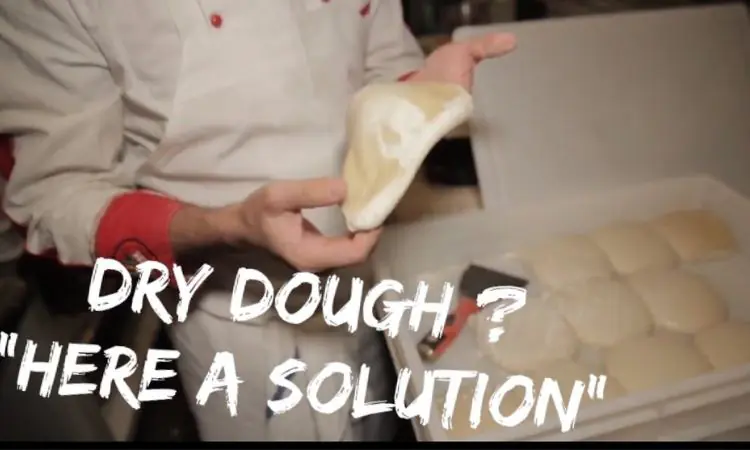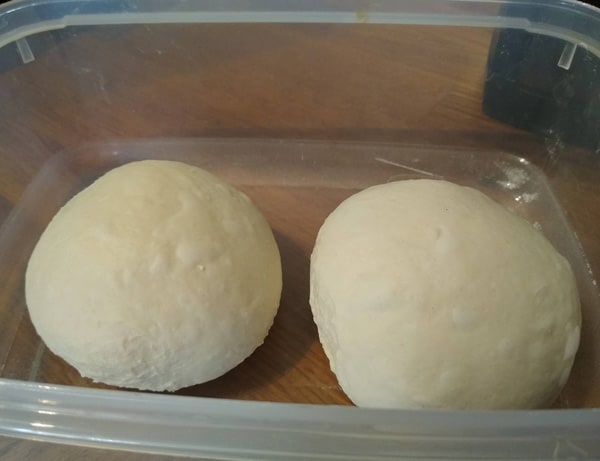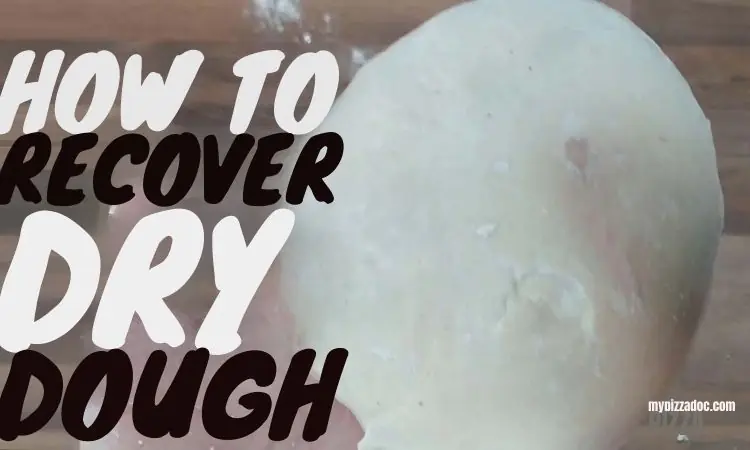If the pizza dough is too dry, gradually add small amounts of warm water and knead. Ensure water integration is even for optimal texture.
Crafting the perfect pizza dough can be a symphony of simplicity and precision. A common hurdle for both novice and seasoned bakers is dough that’s too dry, which can lead to a tough and crumbly crust, disrupting the pizza’s harmony.
Striking the proper moisture balance is crucial for a dough that’s pliable and ready to transform into a delectable canvas for your toppings. Tackling the dryness early on is critical to achieving the ideal consistency that results in a delicious, golden-brown crust that is both crisp and chewy. This problem often arises due to environmental factors like low humidity or flour with a higher absorption rate, making dough hydration an essential step in pizza preparation. So, before panic sets in, remember that a simple adjustment to your dough’s moisture can save the day.
The Perils Of Dry Pizza Dough
Making pizza at home can be a delightful experience. That is until you encounter the dreaded scenario of dough that’s too dry. Dry pizza dough can lead to a host of issues, from difficult handling to a tough end product, instead of the airy and chewy crust pizza lovers dream of. To avoid this culinary pitfall, let’s delve into the root causes and symptoms of dry dough.
Common Reasons For Dough Dryness
Several factors may make your pizza dough turn out drier than the Sahara. Recognizing these can save your dough:
Indicators Of Excessively Dry Dough
Spotting dry dough is easy if you know what to look for:
| Indicator | What You’ll See or Feel |
| Texture: | The dough feels tough and isn’t pliable. |
| Appearance: | Surface cracks appear, looking like parched earth. |
| Handling: | Dough snaps back when stretched, resisting shaping. |
By keeping an eye out for these signs, you’ll be able to catch a dry dough dilemma before it ruins your pizza-making adventure.
Hydrate To Regenerate
Reviving dry pizza dough is simpler than it seems. Picture this: you’re crafting your homemade pizza, and you discover your dough has lost its pliable charm. Fear not, pizza lovers! Transform that dry dough back to its former glory with a touch of hydration. In the section below, learn the secrets to restore its supple texture, ensuring a perfect pizza base every time.
Adding Water: Techniques For Rescue
Water can work wonders on dry dough. But the key is to add it slowly. Let’s explore the tricks:
Patience is paramount – avoid dumping water in a rush!
| Amount of Water | Action Required |
| 1 tablespoon | Knead until incorporated |
| More, if needed | Add gradually and knead |
Oil: A Double-duty Moisturizer
Oil isn’t just for pans – it’s dough’s hydrating friend. Olive oil, particularly, offers moisture and flavor. Here’s what to do:
Remember: A little goes a long way.
Knead For Need
Perfect pizza dough seems elusive when it feels too dry. Don’t worry! A dry dough can often find new life through proper kneading. Kneading helps distribute moisture. It develops gluten. This gives the dough elasticity and strength. Let’s explore the art of kneading to rescue that dry pizza dough.
The Art Of Kneading For Dough Hydration
Kneading dough isn’t just a motion; it’s a baker’s secret. When too dry pizza dough requires more than simply adding water. It craves proper integration of that extra moisture. Here’s what to do:
Expect to spend up to 10 minutes on this task. Persistence is key!
Kneading Warmth: Using Temperature To Your Advantage
Sometimes, dry dough needs a touch of warmth. Warmth can make the dough more flexible. It can help absorb moisture better. Follow these tips:
Remember, too much heat can kill yeast. Use warm—not hot—temperatures.

Cover And Relax
Cover and Relax — this simple step can transform your too-dry pizza dough into perfect, pliable bliss. Dry dough can result from too much flour or not enough water. Don’t worry! Place your dough in a bowl, and follow these essential tips. They’ll restore moisture and elasticity, preparing your dough for a delicious pizza night!
The Role Of Resting
Resting is the dough’s time to unwind. During this stage, gluten strands relax, and the dough becomes easier to shape. It also allows the dough to absorb moisture evenly. This makes the crust tender and the final product much tastier. Cover your dough with a damp cloth or plastic wrap. Let it sit at room temperature. Give it at least 30 minutes. For really stubborn dough, an hour or longer works wonders. Your patience will be the secret ingredient for an amazing crust.
Ideal Conditions For Dough Proofing
Creating the perfect proofing environment is key to reviving dry dough. Aim for a warm spot with temperatures around 75-85°F. This warmth helps yeast wake up and start working. Stay away from drafty areas and direct sunlight, though. These can cause uneven proofing. Keep your dough covered to lock in moisture. With these ideal conditions, your dough will rise beautifully. It will get ready for the oven, promising a delicious, golden pizza base.
When To Start Over
Have you been kneading tirelessly, yet your pizza dough remains crumbly and dry? It could signal the need for a fresh start. Understanding when to persevere or begin anew is crucial in baking. Let’s explore signs that warrant a new batch of dough.
Recognizing Irreversible Dough
Dry pizza dough often lacks elasticity, failing to stretch without tearing. Spotting this is critical:
Once these signs appear, it might be too late to save the dough. Starting anew might be the best option.
Fresh Beginnings: Tips For Making New Dough
Embarking on a fresh dough batch should be inspiring. Here’s how to ensure success:
Remember, patience is your ally. Allow the dough to rest for gluten to develop. This yields a pliable and resilient dough. Aim for perfection with each new batch, and you’ll master the craft of pizza dough in no time.

Credit: mypizzacorner.com
Prevention For Future Bakes
Struggling with dry pizza dough can turn a fun baking experience sour. The key to avoiding this is to focus on preventing the issue before it starts. Understand the root causes and implement these preventive steps in future bakes to ensure your pizza dough remains perfectly pliable and ready for delicious toppings.
Measuring Matters: Precision In Ingredients
Exact measurements are the cornerstone for flawless dough. Follow these tips:
Humidity And Storage: Controlling Dough Environment
The dough’s environment plays a crucial role. Adhere to these practices:
| Environment Factor | Best Practice |
| Humidity | Store flour in airtight containers. This prevents moisture absorption. |
| Temperature | Keep your ingredients at room temperature before mixing. |

Frequently Asked Questions On What To Do If Pizza Dough Is Too Dry
Why Is My Pizza Dough Too Dry?
Dry pizza dough often results from not enough water during mixing. Measure ingredients accurately and add water gradually until you reach the desired consistency.
How Can I Fix Dry Pizza Dough?
To fix dry dough, knead in small amounts of warm water. Do this gradually and let it rest to absorb fully. Avoid adding too much at once to prevent stickiness.
What Causes Pizza Dough To Not Stretch?
Insufficient hydration or gluten development can prevent dough from stretching. Ensure proper water content and knead dough adequately for elasticity and extensibility.
Can You Add Oil To Dry Pizza Dough?
Yes, adding a bit of olive oil can enrich dry pizza dough. It helps to moisturize the dough and improve its texture. Use high-quality oil for the best results.
Conclusion
Wrapping up pizza dough that’s too dry isn’t the end of your culinary adventure. By adding moisture and kneading it well, you can revive its elasticity. So the next time your dough feels like a desert, remember these simple fixes.
Your perfect pizza awaits!

As the author of the “Ultimate Pizza Guide: Recipes, Tips & Secrets Revealed,” I’m dedicated to sharing my love for pizza and empowering others to create delicious homemade pizzas with ease. Join me on a journey to uncover the secrets to perfecting your pizza game!


